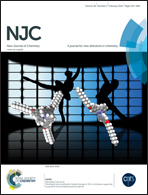Multifunctional Fe3O4–CdTe@SiO2–carboxymethyl chitosan drug nanocarriers: synergistic effect towards magnetic targeted drug delivery and cell imaging†
Abstract
In this study, novel multifunctional core shell structure Fe3O4–CdTe@SiO2–carboxymethyl chitosan drug nanocarriers (MDNs) were developed from carboxymethyl chitosan (CMCS) and magnetic fluorescent composite nanoparticles (Fe3O4–CdTe@SiO2). After processing parameters affecting the end product properties were systematically optimized, Doxorubicin (DOX), a weak base type in clinic anti-cancer drug, was successfully incorporated into the polymeric complex. The formed the MDNs show a uniform size around 160 nm, good loaded content (7.06%) and encapsulation efficiency (76.8%), water-dispersion and colloidal stability in a physiological environment, magnetic movability and red emission at room temperature. In the study of the DOX cumulative release from the MDNs, it could reach 64% at pH 5.3 and 33% at pH 7.4 within 24 h, showing pH-regulated drug release. In in vitro experiments, blank MDNs exhibited excellent biocompatibility even at the high concentration of 1 mg mL−1, and favourable fluorescent labelling properties overcoming cellular barriers to enter the intracellular region and light up the cells. For cancer cell treatment (human prostate cancer cell line PC3M), when 200 μg mL−1 of DOX loaded MDNs was used, they showed obvious anti-cancer activity and a satisfactory therapeutic effect. These characteristics made the as-synthesized MDNs an attractive candidate for the encapsulation and controlled release of an anti-cancer drug for magnetic targeted delivery, fluorescence imaging and cancer treatment.


 Please wait while we load your content...
Please wait while we load your content...